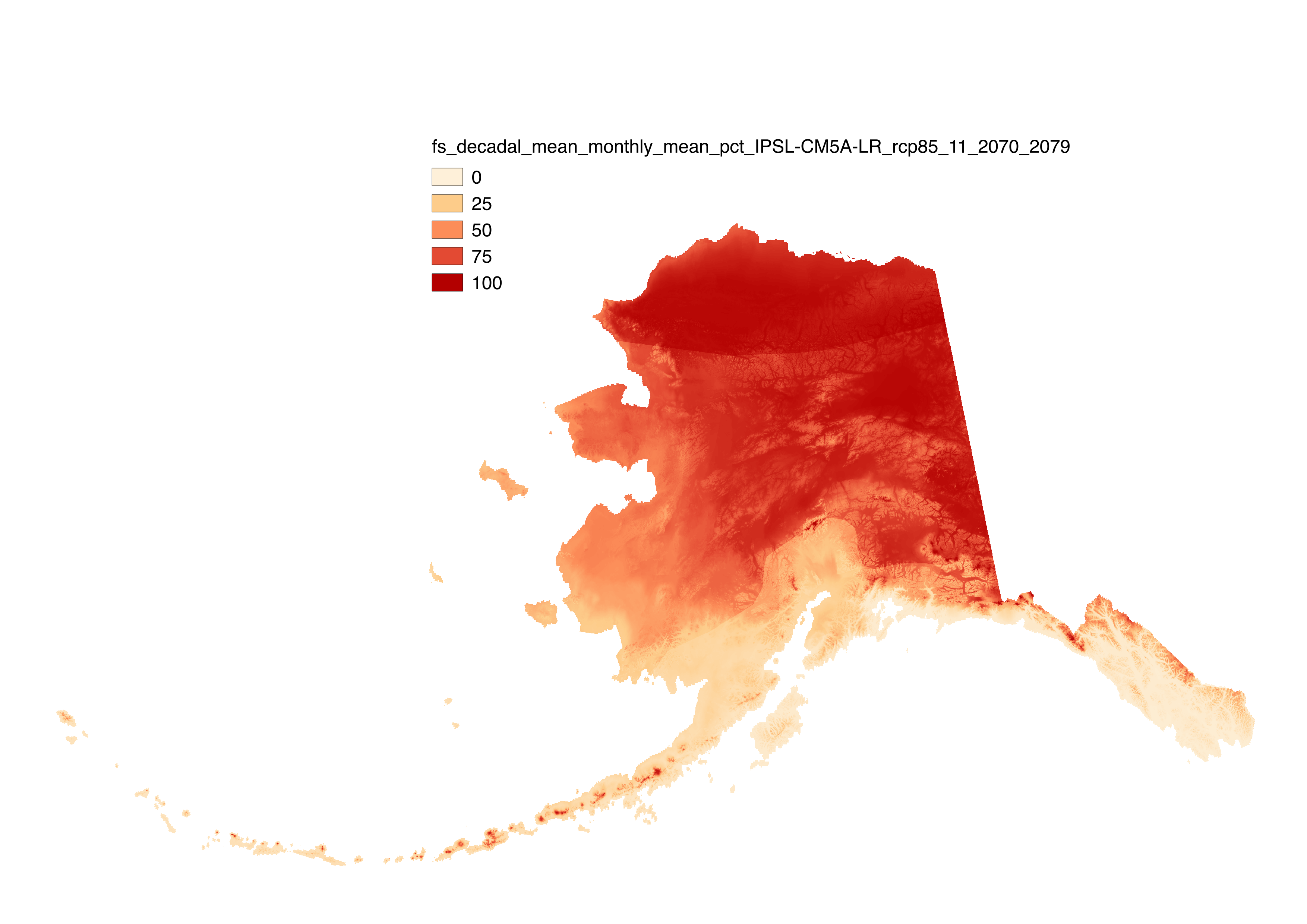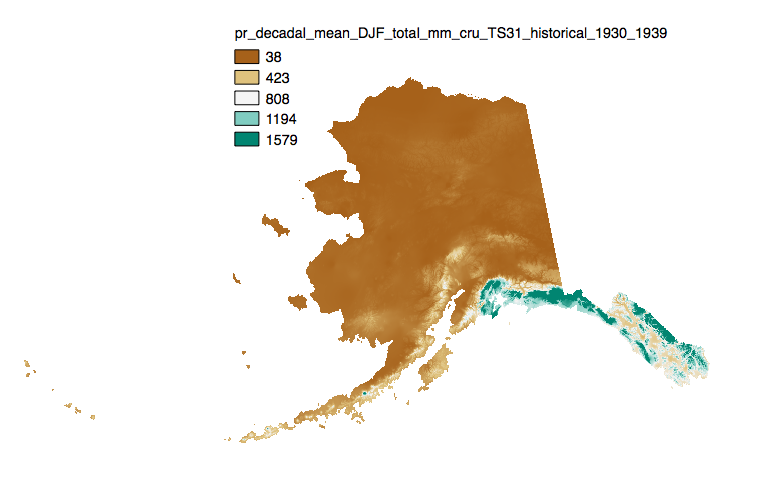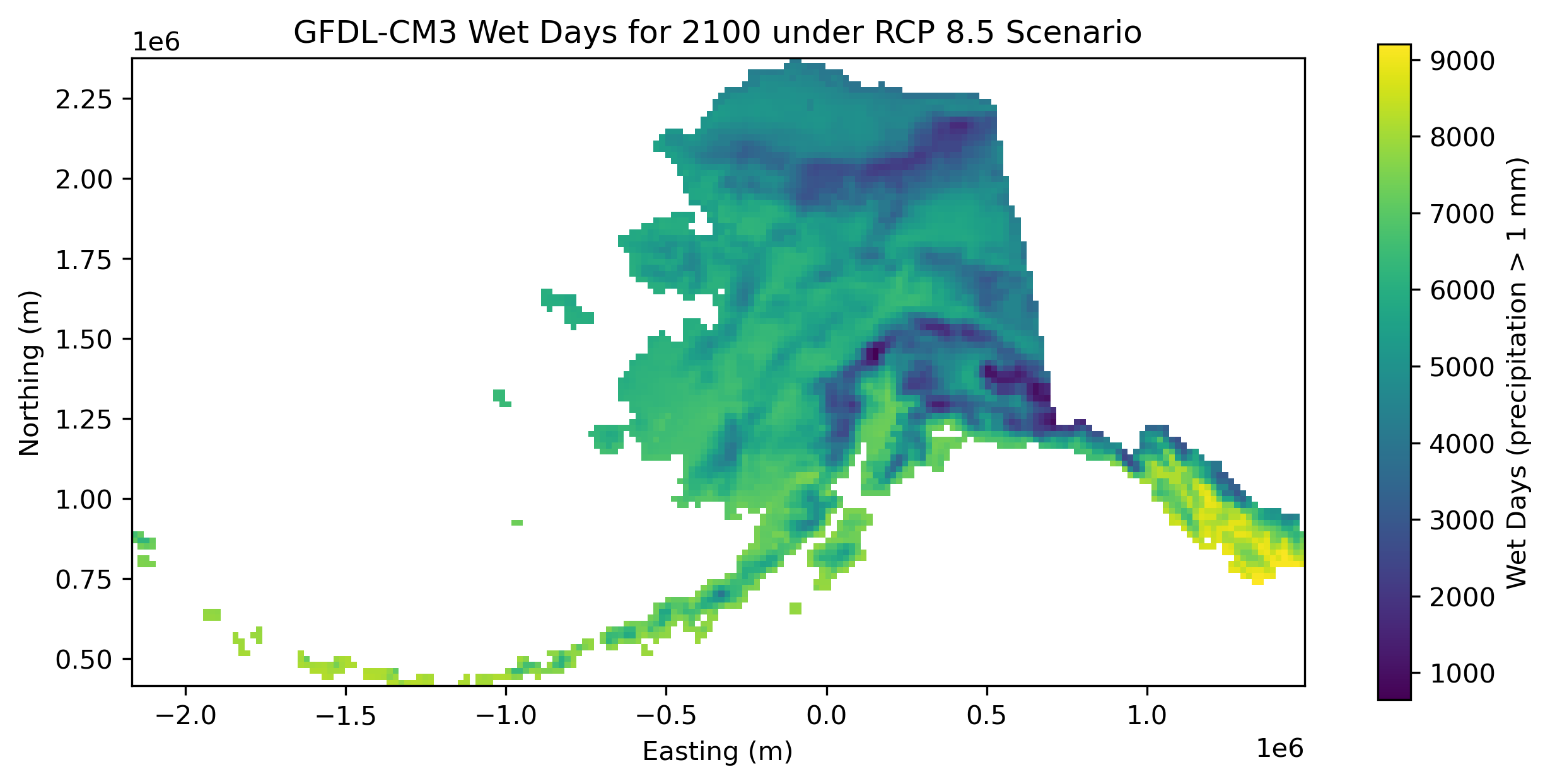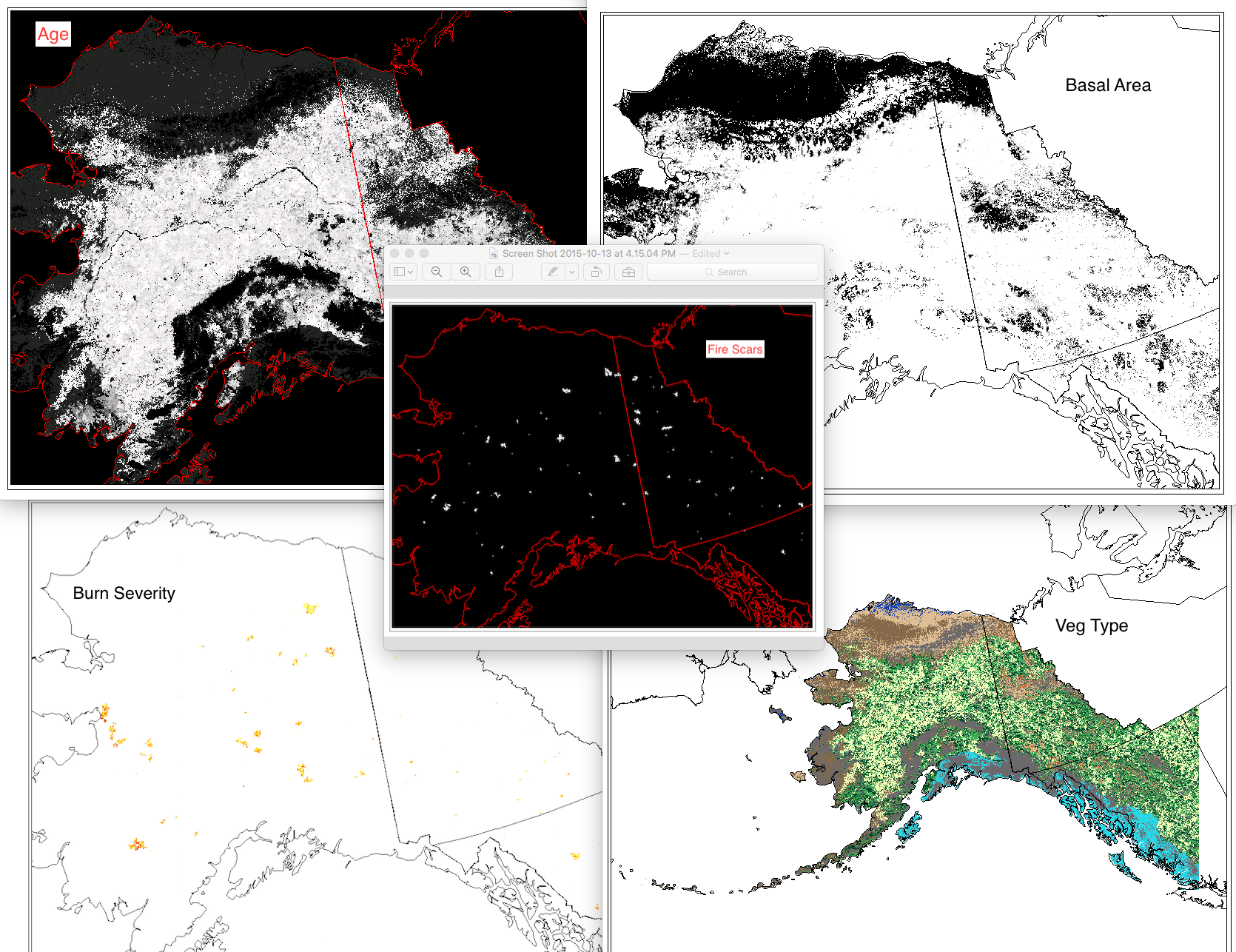Climatology, meteorology, atmosphere
Type of resources
Topics
Keywords
Contact for the resource
Provided by
Years
Formats
Representation types
Update frequencies
status
Scale
Resolution
-
Southeast Alaska is a topographically complex region that is experiencing rapid rates of change with climate regimes that range from temperate rainforest to expansive glaciers and icefields. Global climate models – with a typical spatial resolution of 100 km – poorly resolve this area, while recent downscaling efforts have sought to improve upon existing deficiencies. This research produced hourly dynamically downscaled climate model simulations at 1- and 4-km spatial resolution for both historical (1981-2019) and future periods (2031-2060) across Southeast Alaska. Particular focus was placed on three key watersheds: 1) Montana Creek near Juneau, 2) Indian River near Sitka and 3) Staney Creek on Prince of Wales Island. The projected simulations were based on the representative concentration pathway 8.5 (RCP8.5) emissions scenario. The simulations included the historical Climate Forecast System Reanalysis, and two climate models (the Community Climate System Model, version 4 and the Geophysical Fluid Dynamics Laboratory Climate Model, version 3), which were both run for historical and future periods. All downscaling simulations were run using a 17-month spin-up period to sufficiently generate the land surface state and the lateral boundary conditions for each were updated every 6 hours to constrain the output. The downscaling was completed using the Weather and Research Forecasting Model, version 4.0.
-
This data set consists of PRSIM precipitation climatologies for Alaska in GeoTIFF format. The files in this data set are available from the PRISM Climate Group as text files but have been processed into GeoTIFFs. These are monthly climatologies with a resolution of 771m. Units are millimeters. There are multiple climatological periods currently available through PRISM, but only one is currently available through SNAP in this dataset: 1971-2000.
-
This dataset consists of four different sub-datasets: degree days below 65°F (or "heating degree days"), degree days below 0°F, degree days below 32°F (or "freezing index"), and degree days above 32°F (or "thawing index"). All were derived from the same dataset of outputs from dynamically downscaling one reanalysis (ERA-Interim) and two CMIP5 GCMs (GFDL-CM3, NCAR-CCSM4) over Alaska using the Weather Research and Forecasting model (WRF). Data from the GCMs are driven exclusively by the RCP 8.5 emissions scenario. Heating degree days, degree days below 0°F, and freezing index were computed in the following way: subtract the daily mean temperature values from the threshold value and compute the sum of this time series for the given calendar year. Thawing index is instead computed as the annual sum of the quantities resulting from subtracting the threshold (32°F) from the daily mean temperature values.
-

These files include downscaled projections of decadal average monthly snow-day fraction ("fs", units = percent probability from 1 – 100) for each month of the decades from 2010-2019 to 2090-2099 at 771 x 771 m spatial resolution. Each file represents a decadal average monthly mean. Output is available for the CCSM4, GFDL-CM3, GISS-E2-R, IPSL-CM5A-LR, and MRI-CGCM3 models and three emissions scenarios (RCP 4.5, RCP 6.0 and RCP 8.5). These snow-day fraction estimates were produced by applying equations relating decadal average monthly temperature to snow-day fraction to downscaled decadal average monthly temperature. Separate equations were used to model the relationship between decadal monthly average temperature and the fraction of wet days with snow for seven geographic regions in the state: Arctic, Western Alaska, Interior, Cook Inlet, SW Islands, SW Interior, and the Gulf of Alaska coast, using regionally specific logistic models of the probability that precipitation falls as snow given temperature based on station data fits as in McAfee et al. 2014. These projections differ from McAfee et al. 2014 in that updated CMIP5 projected temperatures rather than CMIP3 temperatures were used for the future projections. Although the equations developed here provide a reasonable fit to the data, model evaluation demonstrated that some stations are consistently less well described by regional models than others. It is unclear why this occurs, but it is likely related to localized climate conditions. Very few weather stations with long records are located above 500m elevation in Alaska, so the equations used here were developed primarily from low-elevation weather stations. It is not clear whether the equations will be completely appropriate in the mountains. Finally, these equations summarize a long-term monthly relationship between temperature and precipitation type that is the result of short-term weather variability. In using these equations to make projections of future snow, as assume that these relationships remain stable over time, and we do not know how accurate that assumption is. These snow-day fraction estimates were produced by applying equations relating decadal average monthly temperature to snow-day fraction to downscaled projected decadal average monthly temperature. The equations were developed from daily observed climate data in the Global Historical Climatology Network. These data were acquired from the National Climatic Data Center in early 2012. Equations were developed for the seven climate regions described in Perica et al. (2012). Geospatial data describing those regions was provided by Sveta Stuefer. Perica, S., D. Kane, S. Dietz, K. Maitaria, D. Martin, S. Pavlovic, I. Roy, S. Stuefer, A. Tidwell, C. Trypaluk, D. Unruh, M. Yekta, E. Betts, G. Bonnin, S. Heim, L. Hiner, E. Lilly, J. Narayanan, F.Yan, T. Zhao. 2012. NOAA Atlas 14. Precipitation-Frequency Atlas of the United States.
-
This data set consists of PRSIM mean air temperature climatologies for Alaska in GeoTIFF format. The files in this data set are available from the PRISM Climate Group as text files but have been processed into GeoTIFFs. These are monthly climatologies with a resolution of 771m. Units are degrees Celsius. There are multiple climatological periods currently available through PRISM, but only one is currently available through SNAP in this dataset: 1971-2000.
-
This dataset includes PRISM derived 1961-1990 climatologies of monthly average, maximum, and minimum temperature and total precipitation across Alaska and Western Canada including the Yukon, British Columbia, Alberta, Saskatchewan, and Manitoba. These were obtained from the PRISM Climate Group and mosaicked into a single continuous transboundary extent. Please cite the PRISM Climate Group when using this data.
-

This set of files includes downscaled historical estimates of monthly totals, and derived annual, seasonal, and decadal means of monthly total precipitation (in millimeters, no unit conversion necessary) from 1901 - 2006 (CRU TS 3.0) or 2009 (CRU TS 3.1) at 771 x 771 meter spatial resolution.
-

This dataset consists of single band GeoTIFFs containing total annual counts of wet days for each year from 1980-2100 for one downscaled reanalysis (ERA-Interim, 1980-2015) and two downscaled CMIP5 global climate models driven under the RCP 8.5 baseline emissions scenario (NCAR-CCSM4 and GFDL-CM3, 2006-2100), all derived from the same dynamical downscaling effort using the Weather Research and Forecasting (WRF) model (Version 3.5). A day is counted as a "wet day" if the total precipitation for that day is 1 mm or greater.
-

This set of files includes downscaled historical estimates of monthly total precipitation (in mm, no unit conversion necessary) from 1901 - 2005, at 15km x 15km spatial resolution. They include data for Alaska and Western Canada. Each set of files originates from one of five top ranked global circulation models from the CMIP5/AR5 models and RCPs, or is calculated as a 5 Model Average. These outputs are from the Historical runs of the GCMs. The downscaling process utilizes CRU CL v. 2.1 climatological datasets from 1961-1990 as the baseline for the Delta Downscaling method.
-

This set of files includes annual model outputs from ALFRESCO, a landscape scale fire and vegetation dynamics model. These specific outputs are from the Integrated Ecosystem Model (IEM) project, and are from the linear coupled version using AR4/CMIP3 climate inputs (IEM Generation 1-AR4) and AR5/CMIP5 climate inputs (IEM Generation 1-AR5). These outputs include data from model rep 171(IEM Generation 1-AR4) and rep 26 (IEM Generation 1-AR5), referred to as the “best rep” out of 200 replicates. The best rep was chosen through comparing ALFRESCO’s historical fire outputs to observed historical fire patterns. Single rep analysis is not recommended as a best practice, but can be used to visualize possible changes. Climate models and emission scenarios: IEM Generation 1-AR4/CMIP3 CCCMA-CGCMS-3.1 MPI-ECHAM5 under the SRES A1B scenario IEM Generation 1-AR5/CMIP5 MRI-CGCM3 NCAR-CCSM4 under RCP 8.5 scenario Variables include: Veg: The dominant vegetation for this cell. Current values are: 0 = Not Modeled 1 = Black Spruce 2 = White Spruce 3 = Deciduous Forest 4 = Shrub Tundra 5 = Graminoid Tundra 6 = Wetland Tundra 7 = Barren / Lichen / Moss 8 = Temperate Rainforest Age: This the age of the vegetation in each cell. An Age value of 0 means it transitioned in the previous year. Basal Area: The accumulation of basal area of white spruce in tundra cell, and is influenced by seed dispersal, growth of biomass, climate data, and other factors. units = m^2 / ha Burn Severity: This is a categorical burn severity level of the previous burn in the current cell, influenced by fire size and slope. For example, a burn severity value in a file with year 1971 in the file name means that the severity level given to that file occurred in the fire that occurred in year 1970. 0=No Burn 1=Low 2=Moderate 3=High w Low Surface Severity 4=High w/ High Surface Severity Fire Scar: These are the unique fire scars. Each cell has three values. Band 1 - Year of burn Band 2 - Unique ID for the simulated fire for that simulation year Band 3 - Whether or not the cell was an ignition location for a fire. There will only be 1 ignition cell per fire per year. 0 = not ignition 1 = ignition point For background on ALFRESCO, please refer to: Is Alaska's Boreal Forest Now Crossing a Major Ecological Threshold? Daniel H. Mann, T. Scott Rupp, Mark A. Olson, and Paul A. Duffy Arctic, Antarctic, and Alpine Research 2012 44 (3), 319-331 http://www.bioone.org/doi/abs/10.1657/1938-4246-44.3.319
 SNAP GeoNetwork
SNAP GeoNetwork